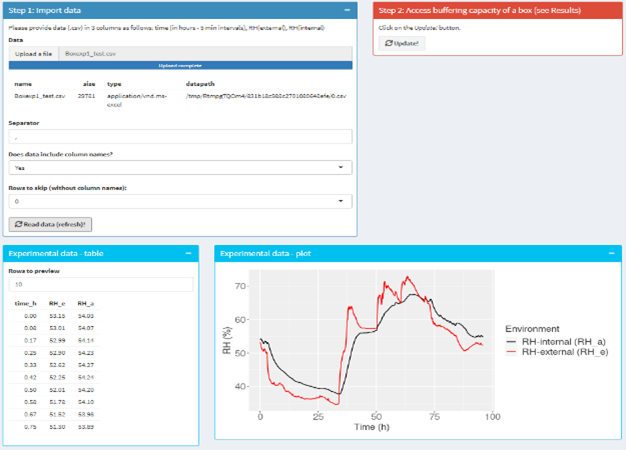APACHE aim is to find a solution to the long-term preservation questions raised by billions of objects collected in museum, library and archive storages by developing
1. APP for assessing buffering capacity of an enclosure
The App is a decision tool that allows to better understand the behaviour of relative humidity (RH) inside an enclosure when exposed to different types of external RH fluctuations. It uses direct measurements of RH fluctuation, taking into account the properties of the enclosure. This App has been developed using Shiny from R Studio https://shiny.rstudio.com/


2. Novel Materials for preservation of cultural heritage
Different materials have been developed to create a stable environment, and limit temperature and relative humidity variation.
- Modified-corrugated cardboards with enhanced thermal performances: they can stabilize temperature and relative humidity exploiting the potentials of polymer composites (PCMs and Silica Aerogels). These composites show ease of preparation and deposition on corrugated cardboards, good adhesion, low shrinkage after water evaporation and no significant aesthetical alterations.
- Boards coated with Polyvinylalcohol membranes (PVA) and Super Absorbent Polymers (SAPs) able to regulate RH (photo).
- High-quality graphene membranes as a protective coating for humidity protection on artwork. The graphene veil absorbs the UV light and delays the diffusion of oxidizing species.
3. Volatile organic compound (VOC) absorbers
During this project novel absorbents for VOCs and pollutants have been created starting from a multi-scale modelling that helped in the determination of the optimal characteristics of the absorbents.
- The Max Planck Institute For Polymer Research have developed an All Atom model to study bulk and films systems and their interactions with VOCs.
- A new material by CSGI, resistant and flexible, biodegradable and with tunable porosity based on Castor oil and polyurethanes, able to absorbs pollutants
- Development of a highly performant cellulose-silica foam (high absorbing capacity, green-based easy to handle etc…) able to capture of gaseous pollutants in museums and archives.
- Novel aerogels (photo) able to absorb organic and inorganic pollutants. They are bio-compatibles, they can be used on large surface areas and have high oxidization resistance at high temperature


4. Nover sensor
Two kinds of sensors targeting detection of VOCs, pollutants, humidity and temperature-regulator have been fabricated: short-range sensor and long-range sensor. These sensors use Wireless Sensor Technology to transfer data: Tyndall developed a Near-Field Communication (NFC) sensor that can be placed in smart archive boxes developed by ZFB (photo), and a LoRa Sensor that can be used in large areas (<100m2). Ericsson developed and demonstrated a proof-of-concept of a communication solution for exhibition rooms and storage areas based on Bluetooth technology.
5. Display cases
Finally, the novel chemisorbents have been tested in two display cases fabricated by Goppion characterized by a fully transparent display area (photo). Thanks to these cases coupled with the sorbents, there is a stable microenvironment and thus full control of indoor air quality.

